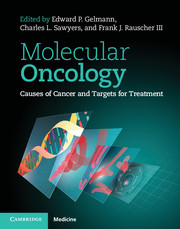Book contents
- Frontmatter
- Dedication
- Contents
- List of Contributors
- Preface
- Part 1.1 Analytical techniques: analysis of DNA
- Part 1.2 Analytical techniques: analysis of RNA
- Part 2.1 Molecular pathways underlying carcinogenesis: signal transduction
- Part 2.2 Molecular pathways underlying carcinogenesis: apoptosis
- Part 2.3 Molecular pathways underlying carcinogenesis: nuclear receptors
- Part 2.4 Molecular pathways underlying carcinogenesis: DNA repair
- Part 2.5 Molecular pathways underlying carcinogenesis: cell cycle
- Part 2.6 Molecular pathways underlying carcinogenesis: other pathways
- Part 3.1 Molecular pathology: carcinomas
- Part 3.2 Molecular pathology: cancers of the nervous system
- Part 3.3 Molecular pathology: cancers of the skin
- Part 3.4 Molecular pathology: endocrine cancers
- Part 3.5 Molecular pathology: adult sarcomas
- Part 3.6 Molecular pathology: lymphoma and leukemia
- Part 3.7 Molecular pathology: pediatric solid tumors
- 77 Pediatric solid tumors: embryonal cell oncogenesis
- Part 4 Pharmacologic targeting of oncogenic pathways
- Index
- References
77 - Pediatric solid tumors: embryonal cell oncogenesis
from Part 3.7 - Molecular pathology: pediatric solid tumors
Published online by Cambridge University Press: 05 February 2015
- Frontmatter
- Dedication
- Contents
- List of Contributors
- Preface
- Part 1.1 Analytical techniques: analysis of DNA
- Part 1.2 Analytical techniques: analysis of RNA
- Part 2.1 Molecular pathways underlying carcinogenesis: signal transduction
- Part 2.2 Molecular pathways underlying carcinogenesis: apoptosis
- Part 2.3 Molecular pathways underlying carcinogenesis: nuclear receptors
- Part 2.4 Molecular pathways underlying carcinogenesis: DNA repair
- Part 2.5 Molecular pathways underlying carcinogenesis: cell cycle
- Part 2.6 Molecular pathways underlying carcinogenesis: other pathways
- Part 3.1 Molecular pathology: carcinomas
- Part 3.2 Molecular pathology: cancers of the nervous system
- Part 3.3 Molecular pathology: cancers of the skin
- Part 3.4 Molecular pathology: endocrine cancers
- Part 3.5 Molecular pathology: adult sarcomas
- Part 3.6 Molecular pathology: lymphoma and leukemia
- Part 3.7 Molecular pathology: pediatric solid tumors
- 77 Pediatric solid tumors: embryonal cell oncogenesis
- Part 4 Pharmacologic targeting of oncogenic pathways
- Index
- References
Summary
Solid tumors that occur in children and adolescents are rare, but have significantly contributed to the understanding of cancer biology. A famous example is Knudson's epidemiologic study of retinoblastoma patients that predicted the role of tumor-suppressor genes in human cancers (1–3). Pediatric solid-tumor investigations were critical to the discovery of pathognomonic chromosomal translocations, which classified difficult-to-diagnose, small round blue-cell tumors, and led to potential targets for novel therapeutics (4). This chapter will provide synopses of pediatric solid tumors where mechanistic insights have provided an understanding of pathobiology and targets for therapy.
Ewing sarcoma
Ewing sarcoma (ES) are comprised of highly malignant neoplasms of bone and soft tissue occurring in children, adolescents, and young adults. ES are defined by the characteristic chromosomal translocation t(11:22) and its fusion-protein product EWS-FLI1. The translocation, or a related variant, occurs in 95% of tumors (5) between the central exons of the EWSR1 gene (EWing Sarcoma breakpoint region 1; chromosome 22) to the central exons of an ets family gene combining it with either FLI1 (Friend Leukemia Integration 1; chromosome 11) or ERG (v-ets erythroblastosis virus E26 oncogene homolog; chromosome 21) t(11;22) and t(21;22), respectively. Additional chromosomal abnormalities associated with disease progression have also been identified (6,7). While rare, deletions of p53 or p16 portend a poor outcome and thus may be linked to the pathophysiology, potentially through tumor resistance to therapy (8).
- Type
- Chapter
- Information
- Molecular OncologyCauses of Cancer and Targets for Treatment, pp. 826 - 835Publisher: Cambridge University PressPrint publication year: 2013

